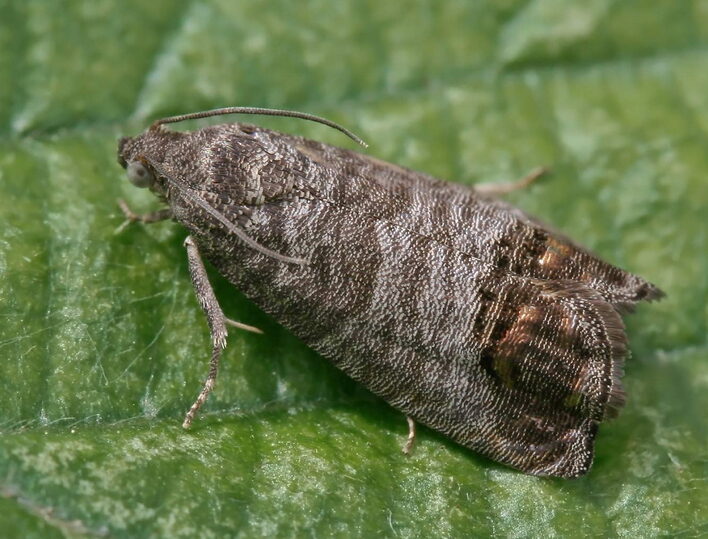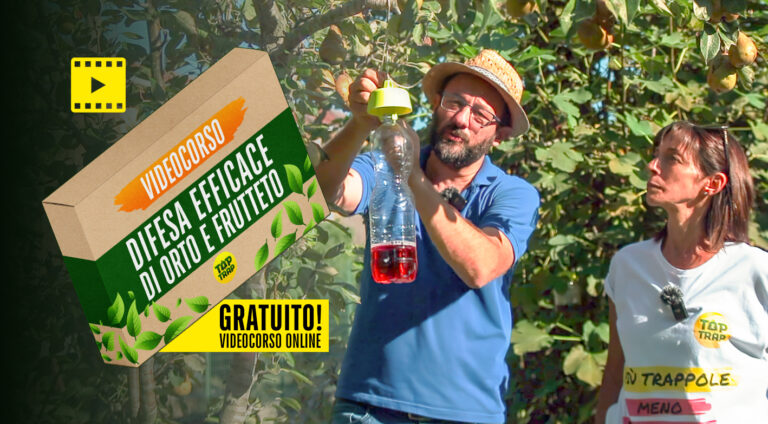
Cydia pomonella is among the most harmful lepidoptera for pome fruit. The larvae damage the fruit by digging tunnels, where they remain until the end of their development. If the attack is not controlled in time, the crop is damaged as the damage it causes to the fruit causes it to fall and therefore cannot be sold.
Class: Insecta
Order: Lepidoptera
Family: Tortricidae
Genus: Cydia
Species: C. Pomonella
Binomial name: Cydia Pomonella (L.)
Larvae: 15 – 20 mm
Adults: wingspan 15 – 22 mm
The codling moth attacks mainly pome plants but can also affect pear, medlar, walnut, nashi, plum, apricot, cherry, persimmon, rowan, orange, pomegranate and chestnut trees.
The larvae are whitish in colour, darkening with development to yellowish and then pinkish.
Adults are butterflies with greyish forewings with transverse bronze streaks that intensify towards the wing margin.
The codling moth performs on average 2 – 3 generations per year at our latitudes.
First generation – The larval stage lasts throughout the winter and the cocoons remain protected under the bark of plants or in the soil. When spring arrives, the larvae pupate. Adults flicker from the larval stage between April and May, when temperatures usually reach 15 – 16 degrees. The butterflies are most active in mating at sunset, and ovipositions occur within a few days, usually on branches and leaves near the fruit. The larval cycle is completed in about 20-30 days.
Second generation – Appears towards the end of June and lays its eggs in already developed fruit: here the larvae have a shorter development and the adults remain active throughout July and August.
Third generation – Does not occur in all areas of Italy. Where it occurs, the adults flicker between August and September and remain active until the end of October. Where, on the other hand, it does not occur, the larvae laid by the second generation enter diapause (stasis of the larval stage) and thus end their annual cycle.
The codling moth deposits its eggs on the leaves and fruit of the crops it infests. The adults are completely harmless, while it is the larvae that are the real culprits of the pest: they attack the fruit from mid-May to September, digging tunnels in the pulp on which they feed until they decay. Once their development is complete, they emerge from the fruit and squat on the trunk, branches or at the base of the plant, until they finish their development cycle.
The codling moth is a carpophagous insect (it feeds exclusively on fruit). Its larvae are capable of piercing the outside of the fruit at any stage of ripening, digging very deep tunnels into the flesh on which they feed, until they reach the seeds in the centre of the fruit. The presence of the carpocapsa can be seen by the hole in the fruit around which a small clump of excrement has formed, which is also found all along the tunnel dug by the larva. At the end of its development, the larva leaves the fruit by digging another tunnel.
The lesions created in the fruit cause it to rot and drop. In the most serious situations, the entire crop is compromised, preventing the fruit from being edible and marketed. In later generations the damage created is more serious: the larvae have a faster trophic activity and feed on more fruit in less time.
The codling moth has no natural antagonists, so it is necessary to implement a prompt and constant anti-insect control as early as May in order to fight its spread, and to continue it throughout the season with different methodologies, both in organic and integrated agriculture. A combined methodology usually proves to be the best strategy:
– an initial monitoring of the insect’s presence by means of pheromone traps (to become aware of the extent of the carpocapsa’s presence)
– a mass trapping with selective ecological traps until the end of the season.
Head Office:
Via Caduti per la Libertà, 39
10044 PIANEZZA (TO)
Warehouse:
Via dei Ronchi, 61
10091 Alpignano (TO)
Tel. +39 011.988.68.40![]() +39 379.2370074
+39 379.2370074
info@taptrap.com

CARELLO ROBERTO di BELLINI VANDA
Copyright © 2024 All rights reserved
VAT no. IT12508090011 – C.F. BLLVND57L43H355W –
N.REA TO1295145

Scopri il nostro videocorso gratuito
DIFESA EFFICACE di Orto e Frutteto
Tanti consigli pratici per prevenire le infestazioni di insetti dannosi in modo ecologico – con Pietro Isolan